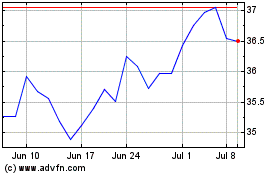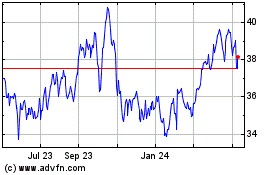U.S. Oil Prices Settle at 2016 High
April 26 2016 - 3:10PM
Dow Jones News
U.S. oil prices settled at a new 2016 high Tuesday as the dollar
fell and traders bet that U.S. oil output would continue to
fall.
However, concerns about persistent market oversupply are
expected to put a cap on gains.
Light, sweet crude for June delivery rose $1.40, or 3.3%, to
$44.04 a barrel on the New York Mercantile Exchange. Brent, the
global benchmark, rose $1.24, or 2.8%, to $45.72 a barrel in ICE
Futures Europe.
Oil was propped up by the dollar, which fell ahead of a meeting
of Federal Reserve officials on Tuesday and Wednesday. The Fed
could drop hints after its meeting about future interest-rate
increases and the strength of the U.S. economy.
The Wall Street Journal Dollar Index, which tracks the greenback
against a basket of other currencies, recently fell 0.3%. As oil is
priced in dollars, it becomes cheaper for holders of other
currencies as the greenback falls.
U.S. oil prices have climbed more than 60% from a 13-year low
reached in February on expectations that production would decline
in the U.S. and elsewhere and that demand would remain robust.
Still, there are few signs that the global oversupply of crude oil
is shrinking, analysts say.
"The supply glut is still dire," said AvtarSandu, commodities
manager at Phillip Futures. "We might see a sharp correction in the
market soon."
Data provider Genscape Inc. said Monday that oil inventories in
Cushing, Okla., a key storage hub in the U.S., rose by about 1.5
million barrels last week. Cushing storage tanks are nearly full,
and concerns about high stockpiles there weighed on oil prices
Monday.
However, traders may be less worried about high inventory levels
due to recent supply outages, Citigroup Inc. said in a note.
"Global supply disruptions are growing and market participants are
more comfortable with elevated levels of crude inventories," the
bank's analysts said.
The U.S. Energy Information Administration will release its
inventory data for last week on Wednesday. The agency will also
report last week's U.S. crude-production level. Domestic output
fell below 9 million barrels a day earlier this month for the first
time since October 2014.
Analysts expect U.S. output to keep falling as companies have
slashed spending on new drilling.
U.S. shale producer Pioneer Natural Resources Co. said Monday
that it would put more drilling rigs to work if prices rise to $50
a barrel.
That price point was perceived as bullish to some market
watchers, who had expected shale producers to ramp up output at $40
or $45 a barrel, said Michael Roomberg, portfolio manager and
analyst at Miller/Howard Investments.
"It could be construed as a barometer for the industry, that
folks are not going to be rushing to put capital and rigs back to
work" until prices hit $50 or higher, Mr. Roomberg said.
Oil major BP PLC reported a second-consecutive quarterly loss on
Tuesday, hurt by weak oil prices and a $917 million pretax charge
relating to the Deepwater Horizon explosion in 2010. But excluding
the Deepwater Horizon costs and other one-time charges, the company
posted a profit of $532 million, beating analysts' consensus
forecast for a loss.
Georgi Kantchev, Jenny W. Hsu and Sarah Kent contributed to this
article.
Write to Nicole Friedman at nicole.friedman@wsj.com
(END) Dow Jones Newswires
April 26, 2016 14:55 ET (18:55 GMT)
Copyright (c) 2016 Dow Jones & Company, Inc.
BP (NYSE:BP)
Historical Stock Chart
From Mar 2024 to Apr 2024

BP (NYSE:BP)
Historical Stock Chart
From Apr 2023 to Apr 2024
